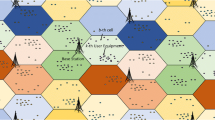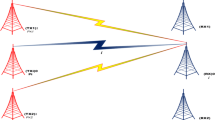Abstract
This paper has proposed a user-density-based coverage optimization technique for ultra-dense cellular networks. Antenna tilting is a promising coverage optimization technique to be used in 5G networks, that significantly improve the signal to interference plus noise ratio (SINR) by choosing the appropriate angle of tilt. In this paper, the cellular coverage has been optimized for scattered user densities/user hotspots using an adaptive antenna tilting mechanism that steers the beams towards the temporal hot spot in the coverage area. The proposed method has the competence to improve the desired SINR level and coverage area for a group of users rather than a single user. In this work, a reinforcement learning (RL) algorithm has been implemented to optimize the tilt angle. The performance of the proposed technique has been evaluated in the simulation platform considering a three-sectored multicellular mobile network where the groups of user clusters are distributed randomly. The result confirms the improvement in RSS and SINR values in the group of users having high density with maximum user satisfaction.






Similar content being viewed by others
Explore related subjects
Discover the latest articles and news from researchers in related subjects, suggested using machine learning.Data availability
Not applicable.
Code availability
Not applicable.
References
Yilmaz, O. N. C., Hamalainen, S., & Hamalainen, J. (2009). System level analysis of vertical sectorisation for 3GPP LTE, 6thIEEE International Symposium on Wireless Communication System, (pp. 453–457), Tuscany.
Siomina, I., Varbrand, P., & Yuan, D. (2006). Automated optimization of service coverage and base station antenna configuration in UMTS networks, in IEEE Wireless Communications, vol. 13, no. 6, (pp. 16–25).
Hamalainen, S., Sanneck, H., & Sartori, C. (2011). LTE self-organising networks (SON): Network management automation for operational efficiency. Wiley.
Chen, S., Qin, F., Hu, B., Li, X. & Chen, Z. (2016). User-centric ultra-dense networks for 5G: Challenges, methodologies, and directions, IEEE Wireless Communications, vol. 23, no. 2, (pp. 78–85).
ITU-R Report M.2320. (2014). Future Technology Trends of Terrestrial IMT Systems.
Dandanov, N., Al-Shatri, H., Klein, A. & Poulkov, V. (2017). Dynamic Self-Optimization of the Antenna Tilt for Best Trade-off Between Coverage and Capacity in Mobile Networks.Wireless Personal Communications: Springer Link, vol. 92, Issue 1, (pp 251–278).
Athley, F., Johansson, M., (2010). Impact of electrical and mechanical antenna tilt on LTE downlink system performance. Proc. IEEE 71st Veh. Technol. Conf., pp. 1–5, May 2010
Yilmaz, O., Hamalainen, S., & Hamalainen, J. (2009). Comparison of remote electrical and mechanical antenna downtilt performance for 3GPP LTE. Vehicular Technology Conference Fall (VTC 2009-Fall)2009 IEEE 70th. pp. 1–5.
Yilmaz, O., Hamalainen, J., & Hamalainen, S. (2010). Self-optimization of remote electrical tilt. Personal Indoor and Mobile Radio Communications (PIMRC), 2010 IEEE 21st International Symposium on. pp. 1128–1132.
Partov, B., Leith, D. J., & Razavi, R. (2015). Utility fair optimization of antenna tilt angles in LTE networks. IEEE/ACM Transactions on Networking, 23(1), 175–185.
Dreifuerst, R., Daultony, S., Qiany, Y., Varkeyy, P., Balandaty, M., Kasturiay, S., Tomary, A., Yazdany, A., Ponnampalamy, V., Heath, R. (2021) Optimizing Coverage and Capacity in Cellular Networks using Machine Learning. IEEE ICASSP 2021.
Razavi, R., Klein, S. & Claussen, H. (2010). Self-optimization of capacity and coverage in LTE networks using a fuzzy reinforcement learning approach, 21st Annual IEEE International Symposium on Personal, Indoor and Mobile Radio Communications, (pp. 1865–1870), Instanbul, doi: https://doi.org/10.1109/PIMRC.2010.5671622.
Berger, S., Fehske, A., Zanier, P., Viering I., & Fettweis, G. (2014). Online antenna tilt-based capacity and coverage optimization, in IEEE Wireless Communications Letters, vol. 3, no. 4, (pp. 437–440).
Dandanov, N., Samal, S. R., Bandopadhaya, S., Poulkov, V., Tonchev, K., & Koleva, P. (2018). Comparison of wireless channels for antenna tilt based coverage and capacity optimization, Global Wireless Summit (GWS-2018) (pp. 119–123). Chiang Rai.
Buenestado, V., Toril, M., Luna-Ramírez, S., Ruiz-Avilés, J. M. & Mendo, A. (2017). Self-tuning of remote electrical tilts based on call traces for coverage and capacity optimization in LTE, in IEEE Transactions on Vehicular Technology, vol. 66, no. 5, (pp. 4315–4326).
Samal, S. R., Dandanov, N., Bandopadhaya, S., & Poulkov, V. (2020). Adaptive antenna tilt for cellular coverage optimization in suburban scenario, in Biologically inspired techniques in many-criteria decision making, learning and analytics in intelligent systems, (Vol. 10). Springer.
Pedras, V., Sousa, M., Vieira, P., Queluz, M., Rodrigues, A., (2017). Antenna tilt optimization using a novel QoE model based on 3G radio measurements. in Proc. 20th Int. Symp. Wireless Pers. Multimedia Commun. (WPMC), Dec. 2017, pp. 124–130.
Ordóñez, P., Luna-Ramírez, S., & Toril, M. (2020). A Computationally Efficient Method for QoE-Driven Self-Planning of Antenna Tilts in a LTE Network. IEEE Access, 8, 197005–197016.
Goldsmith, A. (2005). Wireless communications. Cambridge University Press.
3GPP TR 36.814 V9.0.0, Technical specification group radio access network (E-UTRA). (2010). Evolved Universal Terrestrial Radio Access (E-UTRA), Further advancements for E-UTRA physical layer aspects (Release 9).
Commscope. (2017).Improving metro cell performance with electrical downtilt and upper sidelobe suppression. White Paper.
Funding
Not applicable.
Author information
Authors and Affiliations
Corresponding author
Ethics declarations
Conflict of interest
Not applicable.
Additional information
Publisher's Note
Springer Nature remains neutral with regard to jurisdictional claims in published maps and institutional affiliations.
Rights and permissions
Springer Nature or its licensor holds exclusive rights to this article under a publishing agreement with the author(s) or other rightsholder(s); author self-archiving of the accepted manuscript version of this article is solely governed by the terms of such publishing agreement and applicable law.
About this article
Cite this article
Samal, S.R., Swain, K., Bandopadhaya, S. et al. Dynamic Coverage Optimization for 5G Ultra-dense Cellular Networks Based on Their User Densities. Wireless Pers Commun 128, 605–620 (2023). https://doi.org/10.1007/s11277-022-09969-4
Accepted:
Published:
Issue Date:
DOI: https://doi.org/10.1007/s11277-022-09969-4




